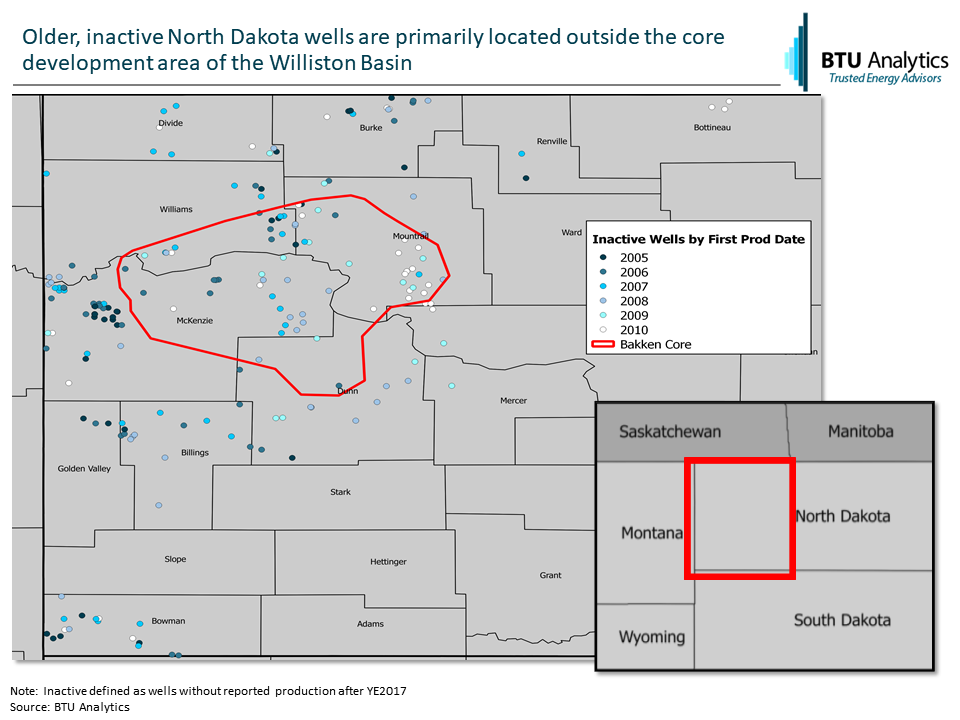Advancements in modern oil and gas well design have spurred producers’ stated well lives to exceed 50 years in some cases. Today’s Energy Market Commentary will explore an unexpected trend present in most major US shale plays – premature well failures. One of the primary concerns with shale development is a steep decline in production over the initial few years of well life. After that point, the decline slows, but at what point should that well be expected to stop contributing production? Analysts might argue that the point should occur when revenue from declining production stops covering operating expenses. However, further analysis of premature well failure rates in the Bakken and Haynesville plays may challenge some industry assumptions.


The Williston Basin’s activity is heavily focused in North Dakota where oil well productivity exceeds earlier Montana development. About 8% of horizontal wells turned to sale from 2005-2010 in North Dakota’s portion of the Bakken have not reported production since 2017. These inactive wells have likely been shut-in because they are no longer capable of producing meaningful volumes of hydrocarbons without costly well repair or stimulation. Most of these shut-in wells will be or already have been plugged and abandoned; however, another option remains. Provisions exist for inactive wells to be granted permits to remain shut-in but unplugged to support future oil and gas activity, such as conversion to saltwater disposal (SWD) wells. Wells turned to sale after 2010 show lower failure rates, but the continuity of improved performance remains to be seen. A continuation of the trend in 2005-2010 shut-ins would significantly reduce future PDP given the larger amount of post-2010 activity driven by high oil prices.

Arguably the biggest driver of improvement in Bakken horizontal well economics over the last 15 years was the identification of the “sweet spot” or core acreage in the basin. Inactive wells that were turned to sale earlier are primarily located outside the core region of the Bakken – portions of Dunn, McKenzie, Mountrail, and Williams counties. The untimely failure of older wells could be attributed to a lack of knowledge of the basin’s sweet spots, but other factors differentiated by well vintage are also in play. Many key components of early horizontal completion designs (types of downhole tools, proppant, frac fluid, perforation spacing, etc.) fell out of favor as empirical data was analyzed and price environments fluctuated. As a result, well longevity problems could have been remedied by subsequent design iterations.
Recent periods of low oil prices constricted producer cash flows significantly. This delayed or prevented workovers that could have resuscitated aging wells. Operators elected to replace PDP with promises of longer-lasting production from new wells instead, but did investors get realistic well life estimates underlying new production forecasts?

The trend of premature well failure is also present in the Haynesville. As with all gas plays, the principal commodity price has been suppressed in recent years by the abundance of associated gas, making it even harder for producers to justify increasing expenses to maintain aging wells. Haynesville activity slowed significantly following 2011, but now the confidence in the lion’s share of its PDP could be called into question by the higher rate of well failures than observed in the Bakken.
Despite our focus on the Bakken and Haynesville in today’s Energy Market Commentary, these two plays are not alone in this predicament. How do these well failures change BTU Analytics’ production outlook? As with all models, production forecasts are only as credible as the assumptions they are built on. To learn more about BTU Analytics’ outlook and methodology, request a sample of our Upstream Outlook.









